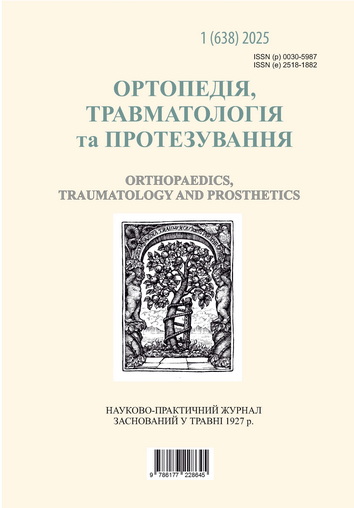OUR EXPERIENCE IN USING MODIFIED BIOACTIVE CERAMICS FOR THE RECONSTRUCTION OF CRITICAL POST-TRAUMATIC BONE DEFECTS
DOI:
https://doi.org/10.15674/0030-59872025121-29Keywords:
Сritical bone defects, Masquelet technique, bone grafting, bioactive ceramics, additive technologies, bone reconstructionAbstract
According to statistical data from the National Military Medical Clinical Center for the period from February to May 2022, bone defects in gunshot fractures accounted for 76 % of cases, with defects exceeding 6 cm — classified as critical — found in 28 % of cases. Currently, the "gold standard" for reconstructing critical bone defects is the induced membrane technique, also known as the two-stage Masquelet technique. The most promising substitute for autologous bone is considered to be biphasic bioactive ceramics. In this study, we aimed to evaluate the feasibility of reconstructing critical bone defects resulting from combat trauma using a modified bioactive ceramic-autograft mixture during the second stage of the Masquelet technique, combined with additive manufacturing technologies. The study included a sample of 36 patients with critical bone defects who underwent reconstruction using the Masquelet technique. During the second stage, the defect was filled with a mixture of calcium phosphate ceramics (CPC) and autologous cancellous bone. We analyzed the treatment outcomes of patients with critical bone defects caused by combat-related injuries over the past 2.5 years who received treatment at the Dobrobut Medical Center. The evaluation criteria included pain levels, range of motion, axial load capacity, functional recovery (work capacity), and radiological signs of callus formation, deformities, graft migration, or remodeling. After 12 months of follow-up: Complete functional recovery (clinically and in range of motion) was achieved in 28 (78 %) patients. Partial functional recovery was observed in 7 (17 %) patients. Significant functional impairment requiring additional surgical interventions occurred in 1 (5 %) patient. Conclusions. Based on our experience, the use of a CPC-autograft mixture in the two-stage reconstruction of critical diaphyseal bone defects provides positive treatment outcomes in most clinical cases. The integration of 3D modeling and biodegradable materials enhances the range of possibilities for performing bone grafting procedures and simplifies technical challenges in reconstructive surgery.
Downloads
How to Cite
Issue
Section
License
Copyright (c) 2025 Vasyl Shmahoi, Nataliia Ulianchych, Maksym Iurzhenko, Volodymyr Kolomiiets, Sergiy Firstov

This work is licensed under a Creative Commons Attribution 4.0 International License.
The authors retain the right of authorship of their manuscript and pass the journal the right of the first publication of this article, which automatically become available from the date of publication under the terms of Creative Commons Attribution License, which allows others to freely distribute the published manuscript with mandatory linking to authors of the original research and the first publication of this one in this journal.
Authors have the right to enter into a separate supplemental agreement on the additional non-exclusive distribution of manuscript in the form in which it was published by the journal (i.e. to put work in electronic storage of an institution or publish as a part of the book) while maintaining the reference to the first publication of the manuscript in this journal.
The editorial policy of the journal allows authors and encourages manuscript accommodation online (i.e. in storage of an institution or on the personal websites) as before submission of the manuscript to the editorial office, and during its editorial processing because it contributes to productive scientific discussion and positively affects the efficiency and dynamics of the published manuscript citation (see The Effect of Open Access).














